AMD Radeon HD 7870 GHz Edition & Radeon HD 7850 Review: Rounding Out Southern Islands
by Ryan Smith on March 5, 2012 12:01 AM ESTPower, Temperature, & Noise
As always, we wrap up our look at a new video card with a look at the physical performance attributes: power consumption, temperatures, and noise. Thanks to TSMC’s 28nm process AMD has been able to offer 6900 series performance on a much smaller chip, but what has that done to power consumption and all of its related properties? Let’s find out.
Please note that we’re including our 7870-based 7850 in these charts, even though none of AMD’s partners will be shipping a card in this exact configuration. Power consumption should be nearly identical to shipping cards, but temperatures and noise readings are going to be significantly different since most of those cards will be using open air coolers.
| Radeon HD 7800 Series Voltages | ||||
| Ref 7870 Load | Ref 7850 Load | Ref 7870 Idle | ||
| 1.219v | 1.213v | 0.85v | ||
When getting a voltage reading on our 7800 cards through GPU-Z, it was interesting to note that the load voltage was almost identical between the two cards: 1.219v versus 1.213v. While we believe GPU-Z is giving us the right readings, we’re not sure whether the 7850 voltages are the same we’ll be seeing on shipping cards because of the PCB differences.

Idle power consumption looks quite good, as you’d expect from GCN. Idle power consumption is virtually identical to the 7900 series at the wall, and only the 7700 series can beat 112W. This further goes to show just how much progress has been made with idle power consumption – the Cayman based 6900 series had good idle power consumption for its time, and yet the 7800 series beats it by 5W+ at the wall.
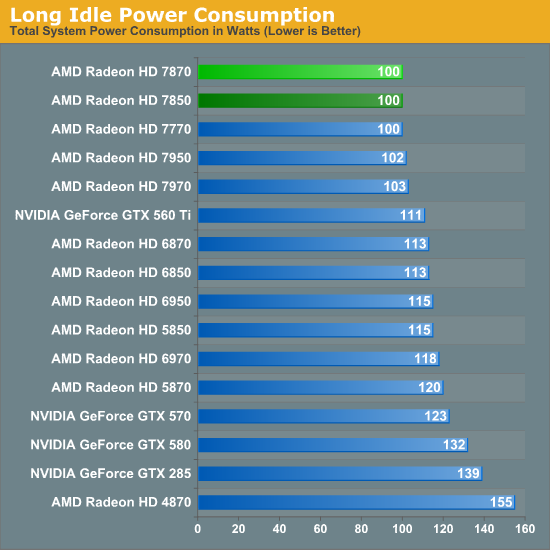
Long idle power consumption is virtually identical with the rest of the Southern Islands cards thanks to AMD’s ZeroCore Power technology. The next closest card is the GTX 560 Ti, and that’s at nearly 10W higher.
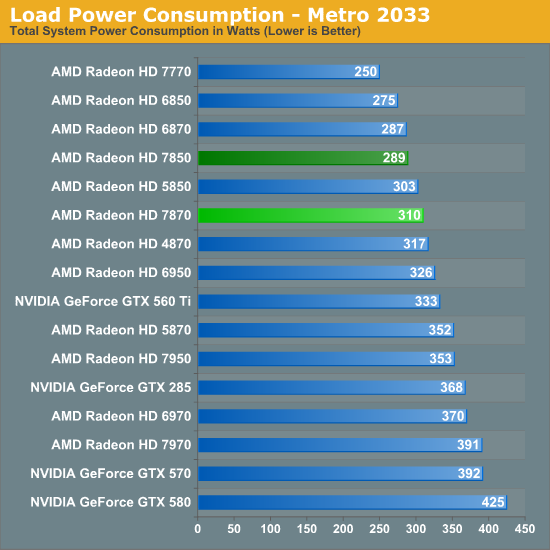
Moving on to load power testing, we have Metro 2033. Load power consumption here is about where you’d expect it to be, with the 7800 setups drawing more at the wall than the 6800 setups, but less than the 7900 and 6900 series. This is largely a consequence of performance, as the higher rendering performance of the 7800 series versus the 6800 series drives up CPU power consumption in order to generate more frames.
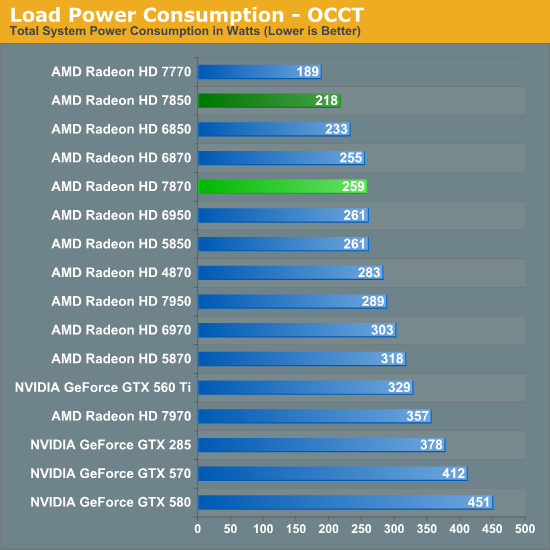
OCCT on the other hand gives us a more purified look at power consumption, and as you’d expect for 28nm it looks good. The 7870 ends up drawing only a few more watts at the wall compared to the 6870, showcasing the fact that the 7800 series is a drop-in replacement for the 6800 series from a power consumption perspective. The 7850 looks even better, capping out at 15W below the 6850, most likely as a result of PowerTune keeping the card firmly at 150W. Though it’s interesting to note that the measurements at the wall don’t perfectly align with the differences in PowerTune limits, with the 7850 drawing 30W more than the 7770 at the wall compared to a 50W PT difference, while the 7950 draws 30W more at the wall over the 7870 even though there’s only supposed to be a 10W PT difference.
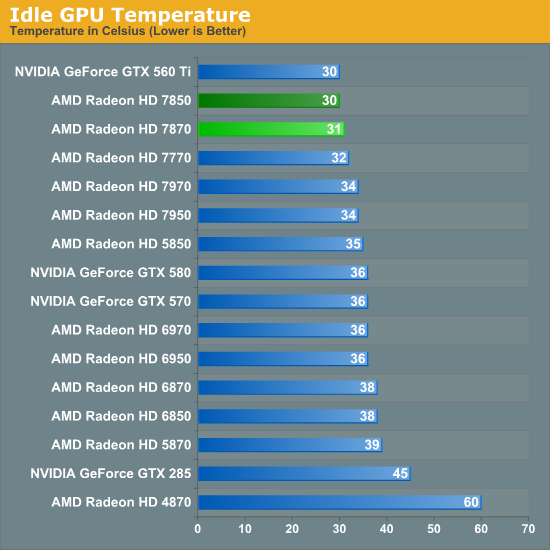
AMD’s latest generation blowers do quite well with idle temperatures and we can see it here. At 30C for the 7850 it’s every bit as cool as the GTX 560 Ti, while the entire 7800 series is around 5-8C cooler than the 6900.
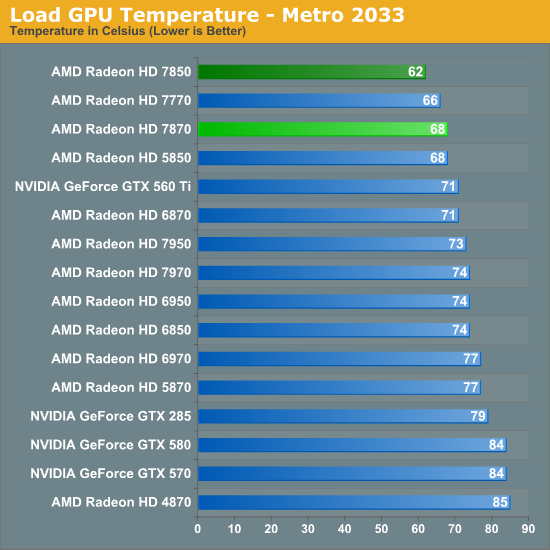
Under load, Metro temperatures are also quite good. At 62C the 7850 is the coolest card in this performance class, but keep in mind that it’s basically using an oversized cooler; retail cards will be open air coolers with much different characteristics. Otherwise at 68C the 7870 is still among the coolest cards, coming ahead of even the historically cool GTX 560 Ti, never mind the much hotter 6900 series.

Load temperatures climb under OCCT, but again the 7800 series is among the coolest temperatures we see. Here we see the 7870 peak at 73C, whereas its last generation counterpart would be at 80C and the GTX 570 at a toasty 87C.
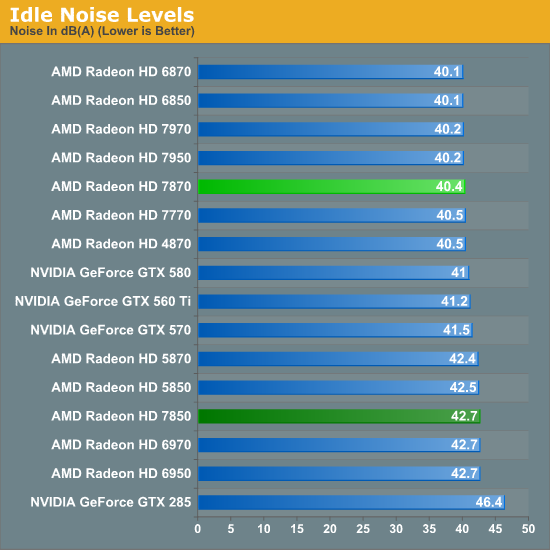
Moving on to noise testing, there are no major surprises at idle, with the 7870 hugging 40db. For whatever reason the 7850’s minimum fan state is roughly 200RPM higher than the 7870’s, but since no one will be using this cooler it’s not a significant result.
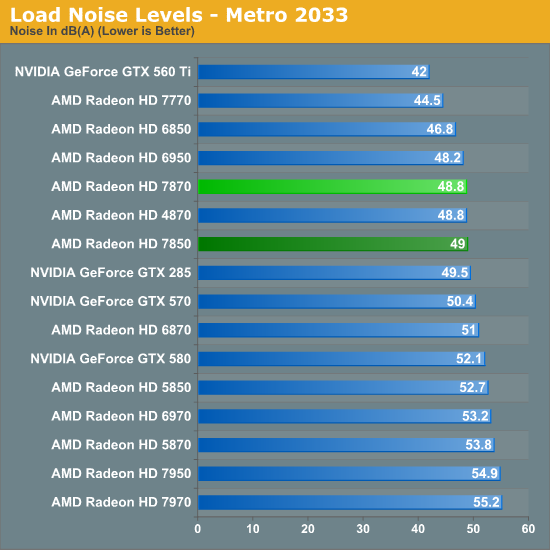
Consistent with AMD’s other 7000 series cards, we’re once again seeing the consequences of AMD’s aggressive cooling policies coupled with the use of a blower. At 48.8dB the 7870 is still quieter than the blower-based 6870, but it’s significantly louder than the open air cooled GTX 560 Ti, even though the latter consumes far more power and generates far more heat. This doesn’t make the use of a blower the wrong choice, but combined with aggressive cooling policies it does hurt AMD. The GTX 570, in spite of using much more power than the 7870, is only less than 2dB louder even though it too uses a blower.

Last, but not least we have our OCCT noise results. Unlike Metro the 7800 series does better on a relative basis here, but this is mostly because NVIDIA doesn’t have a power throttling system quite like PowerTune. At 51.9dB the 7870 is not the quietest card, but it still manages to beat the 6970 and the PowerTune-less 6870.
All things considered there are no great surprises here on a relative basis, as the 7800 series performs like we’d expect for a blower based sub-200W video card. Due to TSMC's 28nm process AMD greatly improves on their performance/power and performance/noise ratios with the 7800 series compared to the 6800 and 6900 series, while for their power class the 7800 series is slightly ahead of the pack on both power consumption and noise.
With that said, keep in mind that since most of AMD’s partners will be using open air coolers these results won’t be applicable to most retail cards. So for the temp/noise characteristics of retail cards you’ll want to look at individual card reviews when those start appearing later this month. This is particularly true for the 7950, where all of the retail cards will be using a different design than our sample.










173 Comments
View All Comments
chizow - Monday, March 5, 2012 - link
Sorry, fact checking 101 says the 7850 is still clearly behind the 570, about 10% faster than the GTX 560Ti ($200). The 7870 may be the SKU you're referring to but it costs $350, which again, brings very little movement on pricing:performance relative to 14-16 month old parts.CeriseCogburn - Thursday, March 8, 2012 - link
Hey don't be so factual. medi01 can also look forward to blurred up MLAA, lack of LOD detail compensation, no PhysX, drivers crashing like mad inexplicably for a year or two until things get "ironed out", new games "not running", mouse cursors stuck in corners, whining about tessellation levels in games "it can't handle", and generally blaming nvidia for all it's failures...The "$80" imaginary dollars he saves he can "reinvest" in a "solid" with a "for sure" payoff - his endless hours "fixing" his 7850 "issues".
SlyNine - Monday, March 5, 2012 - link
That's a very 1 dimensional opinion. Compared to the 5870 node change which equaled 2x performance for around the same price, A fab shrink that doesn't double your performance for the money is disappointing.We are comparing it to how past node changes changed the price/performance model. This one is HORRIBLE because it basically slides right in to the old one, so now we have a node change that does very little for price.
I'm running a 5870 which is basically 75% the performance of a 7970, and I paid 379 for the 5870. Which is also 75% of the cost of a 7970. The price of a 7970 is basically the exact same price structure as the 2 1/2 year old 5870, So we are stuck where we were in 2009, yay.
morfinx - Monday, March 5, 2012 - link
75% performance of 7970 would mean that it's 33% faster than a 5870. And that's just not accurate. I have a 5870 as well, so I was paying a lot of attention on how much faster the 7970 is in various reviews. Everything I've read indicates that it's anywhere from 70-110% faster at 2560x1600 resolution (I run 3600x1920, so likely even even more of a difference). That's not even even considering the massive overclocking headroom of the 7970 vs barely any OC headroom of the 5870. Overclocked, a 7970 is easily twice as fast as a 5870.SlyNine - Thursday, March 8, 2012 - link
I should have said 66% for 66% of the price. Point being the price/Performance has not improved...Its around 40-60% faster according to Anandtech's benchmarks.
Overclocked, don't make me laugh.
chizow - Monday, March 5, 2012 - link
@Kiste: Agreed, don't worry about the criticism you're taking. This site has a lot of readers with very low standards or very limited perspective when it comes to the GPU industry.7000 series pricing and performance is a disappointment so far, there's no doubt about it. You can throw as much historical perspective and factual pricing/performance at them but you''ll just be greeted with blank stares and accusations of fanboyism.
Bottomline is this, if Nvidia follows this price and performance structure, EVERYONE would be disappointed.
If Nvidia took 14-16 months and only improved their entire product stack 15-25% on a new architecture and new process node with Kepler while increasing prices accordingly, it'd be a colossal failure.
It makes you wonder why the AMD fans don't see it the same way?
Kaboose - Monday, March 5, 2012 - link
you're acting like Kepler has been released and Nvidia won't be doing the same exact thing, I really doubt we will see Nvidia releasing higher performing cards then AMD at much lower prices like you see to think.chizow - Monday, March 5, 2012 - link
I didn't say we know what Kepler holds, what I'm saying is *IF* Nvidia did this, it would be a colossal failure and we could just write off 28nm entirely. That's why it makes you wonder why AMD fans are giving them a pass for such little improvement in performance and pricing.Honestly, with 15-25% improvement top to bottom over existing SKUs, Nvidia could have simply refreshed their entire Fermi line-up and hit those targets with just clockspeed increases from the smaller process.
At no other point in the history of GPUs has a new process/architecture from either IHV brought so little movement in price and performance. There's no innovation here and no incentive for anyone who bought in the last few generations to bother upgrading.
If you have a 5850/470 or better, there is VERY little reason to upgrade right now especially at the asking prices.
Kaboose - Monday, March 5, 2012 - link
What % of people have 5850/470 or better GPUs though? Im going to say not many. 7850/7870 are good cards for people entering the market on mid range desktops that want to add a GPU for gaming. As well as HTPC use. And for system builders who are looking for a good OC and current gen. technology.Ananke - Monday, March 5, 2012 - link
See Steam statistics. The 5th series was the majority. The largest target market are owners of 5850/5870. I have 5850 and I can afford any card, but I see no reason to upgrade. At this price point gaming is not the only usage, I want quality hardware video encoding acceleration by MANY software packages, GPGPU applications. Today, in those areas, AMD has actually even less applications than when they launched the 5th series.For SO much money and NO applications outside gaming the ONLY reason not to use NVidia would be heat dissipation. If Kepler cards are colder, NVidia has a win.